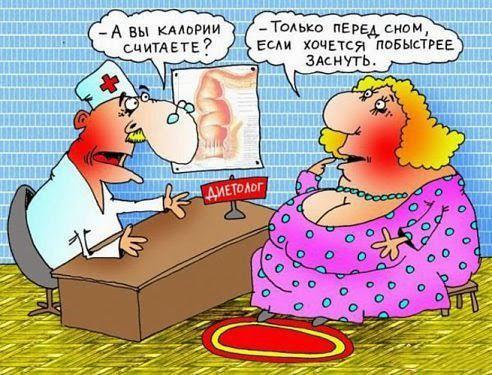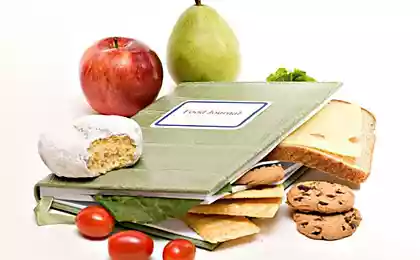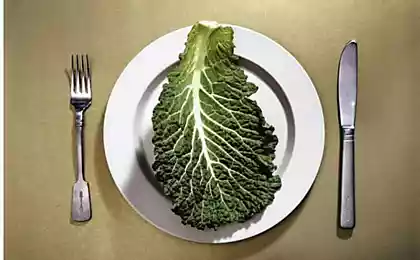503
Counting calories does not work
If you like to read the calorie content on the label, then I have bad news for you. This figure may not have anything to do with reality. Why? There are many reasons, some are discussed below.

1. Your hormonal status.
The higher the insulin levels, the more glucose will go to fat. The higher activity of brown adipose tissue, the more calories you spend, radiating as heat to the outside.
2. Thermal processing of food.
In 2011, Rachel Carmody (Rachel Carmody) and Richard Rengam (Richard Wrangham) from Harvard (USA) published an article which stated that the heat cooking increases the caloric value. Comparing the energy value of the feed, which was prepared with heat treatment or without it, the authors are convinced that in the first case, mouse is produced from the food more calories.
And just recently, in October last year, in American Journal of Physical Anthropology, has released another article in which the same researchers from Harvard University compared how cooking affects the absorption of fats, proteins and carbohydrates. It turned out that after cooking and fats, proteins and carbohydrates "grow" calories – that is, the energy derived from each nutrient molecules increases.
This can be explained on the example of starch, which is thought to be provides on average half of the calories consumed by modern humans. In its natural form it is a granular powder consisting of a plurality of the pellets – once in the digestive tract, the pellets are digested mostly in the small intestine.
If the starch we did not cook, about half of the pellets will remain undigested and undigested, they will either go to feed the intestinal bacteria, or even go to waste. If food has been processed, the particles of starch are much more likely to be digested to glucose, which will easily absorbed from the gut into the blood.

3. Physical grinding of the food
Japanese researchers published in 2003 an article in which he described the experience with the rats and two types of feed: the animals received normal solid food to chew on, while others were given something like whipped grain cereals, saturated with air. Lots of servings, energy value, nutritional composition in both cases was identical, differed only in the method of preparation. However, rats that received air mixture, the result gained 30% more fat than their comrades who ate solid food.
No trickery here, just the digestive system easier to digest the semi-liquid, air, soft ground. On hard food have to spend extra energy to break down. Which, incidentally, can be seen by increasing the temperature of the body: the more energy goes to digestion, the stronger the animal warmed up. Liquid, food lekorotsoana of such efforts does not require energy to digest consumed is small, and the greater the likelihood that unspent energy supply will remain in the body as fat.
Main reasons why solid food less calories :
1. The increased energy cost of chewing, digestion, excretion.
2. Better control saturable (less saturated). Recall that liquid calories are ignored by the body's internal calorie counting does not work.
3. Eat slower, therefore, less will be eaten before the onset of saturation.
4. Smaller peaks of insulin, because cooking and grinding breaks the starch into smaller molecules that are digested faster by amylase to simple carbohydrates.
4. Different biological effect of different substances.
Many of the compounds are indicated on the label in a word, but their biological significance may vary.
For example, "polyunsaturated fatty acids" omega-3 and omega-6 have equal caloric value, but opposite effect. Or compare glucose and fructose: immediately to the fat takes only 5% glucose, 30% fructose. Or starch (full paper in preparation). There are resistant starches, which are consumed by the microflora, and there is the starches regular.
5. The relationship with physical activity.
Calorie counting without accurate counting of the physical and mental work — it is just a number.
6. Different intestinal microflora.
Two different people the same product will be different to digest and calorie counting does not work again. So, fat people are dominated by certain bacteria that promote the absorption of calories. As a rule, when feeding, recovering and microflora.
Counting calories does not work and harms
Unfortunately, for the authors of books on nutrition and diet guru calories have become a perfect means of influencing the emotions of those who struggle with their excess weight. Calories have become one of the biggest sources of confusion in the world of weight loss and undoubtedly this has led to confusion those who want to lose extra pounds. Calorie counting often turns into obsessive-compulsive disorder or in orthorexia.
The caloric content of food is affected, whether we cook and how we cook: roasting and cooking increases the energy value of food, as well as grinding, mixing, and so on. Not to say that it was as much of a secret: dietitians often hear that it is better to eat raw vegetables, not cooked or fried that whole grain bread is healthier bread made from plain white flour, etc.

The number on the label reflects all calories fully split product, excluding cooking and energy costs of digestion.
Of course, you can require the manufacturers of all such options to calculate and specify, but in fact it is very difficult to accurately estimate the amount of energy that can be obtained from the product with a particular method of cooking.
So better to just be aware of the factors affecting the calories and plan your dietbased on whether you need to get as much energy or spend your own some calories.
Of course, the labels occasionally you can watch. And you can sometimes count calories, especially when keeping a food diary. Remember the most important thing: the purpose of calorie counting is knowing and not fixing.published
Used materials: Science and life, How to count calories
Author: Andrey Blueskin
Source: www.beloveshkin.com/2015/02/blog-post_15.html

1. Your hormonal status.
The higher the insulin levels, the more glucose will go to fat. The higher activity of brown adipose tissue, the more calories you spend, radiating as heat to the outside.
2. Thermal processing of food.
In 2011, Rachel Carmody (Rachel Carmody) and Richard Rengam (Richard Wrangham) from Harvard (USA) published an article which stated that the heat cooking increases the caloric value. Comparing the energy value of the feed, which was prepared with heat treatment or without it, the authors are convinced that in the first case, mouse is produced from the food more calories.
And just recently, in October last year, in American Journal of Physical Anthropology, has released another article in which the same researchers from Harvard University compared how cooking affects the absorption of fats, proteins and carbohydrates. It turned out that after cooking and fats, proteins and carbohydrates "grow" calories – that is, the energy derived from each nutrient molecules increases.
This can be explained on the example of starch, which is thought to be provides on average half of the calories consumed by modern humans. In its natural form it is a granular powder consisting of a plurality of the pellets – once in the digestive tract, the pellets are digested mostly in the small intestine.
If the starch we did not cook, about half of the pellets will remain undigested and undigested, they will either go to feed the intestinal bacteria, or even go to waste. If food has been processed, the particles of starch are much more likely to be digested to glucose, which will easily absorbed from the gut into the blood.

3. Physical grinding of the food
Japanese researchers published in 2003 an article in which he described the experience with the rats and two types of feed: the animals received normal solid food to chew on, while others were given something like whipped grain cereals, saturated with air. Lots of servings, energy value, nutritional composition in both cases was identical, differed only in the method of preparation. However, rats that received air mixture, the result gained 30% more fat than their comrades who ate solid food.
No trickery here, just the digestive system easier to digest the semi-liquid, air, soft ground. On hard food have to spend extra energy to break down. Which, incidentally, can be seen by increasing the temperature of the body: the more energy goes to digestion, the stronger the animal warmed up. Liquid, food lekorotsoana of such efforts does not require energy to digest consumed is small, and the greater the likelihood that unspent energy supply will remain in the body as fat.
Main reasons why solid food less calories :
1. The increased energy cost of chewing, digestion, excretion.
2. Better control saturable (less saturated). Recall that liquid calories are ignored by the body's internal calorie counting does not work.
3. Eat slower, therefore, less will be eaten before the onset of saturation.
4. Smaller peaks of insulin, because cooking and grinding breaks the starch into smaller molecules that are digested faster by amylase to simple carbohydrates.
4. Different biological effect of different substances.
Many of the compounds are indicated on the label in a word, but their biological significance may vary.
For example, "polyunsaturated fatty acids" omega-3 and omega-6 have equal caloric value, but opposite effect. Or compare glucose and fructose: immediately to the fat takes only 5% glucose, 30% fructose. Or starch (full paper in preparation). There are resistant starches, which are consumed by the microflora, and there is the starches regular.
5. The relationship with physical activity.
Calorie counting without accurate counting of the physical and mental work — it is just a number.
6. Different intestinal microflora.
Two different people the same product will be different to digest and calorie counting does not work again. So, fat people are dominated by certain bacteria that promote the absorption of calories. As a rule, when feeding, recovering and microflora.
Counting calories does not work and harms
Unfortunately, for the authors of books on nutrition and diet guru calories have become a perfect means of influencing the emotions of those who struggle with their excess weight. Calories have become one of the biggest sources of confusion in the world of weight loss and undoubtedly this has led to confusion those who want to lose extra pounds. Calorie counting often turns into obsessive-compulsive disorder or in orthorexia.
The caloric content of food is affected, whether we cook and how we cook: roasting and cooking increases the energy value of food, as well as grinding, mixing, and so on. Not to say that it was as much of a secret: dietitians often hear that it is better to eat raw vegetables, not cooked or fried that whole grain bread is healthier bread made from plain white flour, etc.

The number on the label reflects all calories fully split product, excluding cooking and energy costs of digestion.
Of course, you can require the manufacturers of all such options to calculate and specify, but in fact it is very difficult to accurately estimate the amount of energy that can be obtained from the product with a particular method of cooking.
So better to just be aware of the factors affecting the calories and plan your dietbased on whether you need to get as much energy or spend your own some calories.
Of course, the labels occasionally you can watch. And you can sometimes count calories, especially when keeping a food diary. Remember the most important thing: the purpose of calorie counting is knowing and not fixing.published
Used materials: Science and life, How to count calories
Author: Andrey Blueskin
Source: www.beloveshkin.com/2015/02/blog-post_15.html
Giant vacuum cleaner will purify the polluted city air
12 reminders for parents from Shalva Amonashvili























